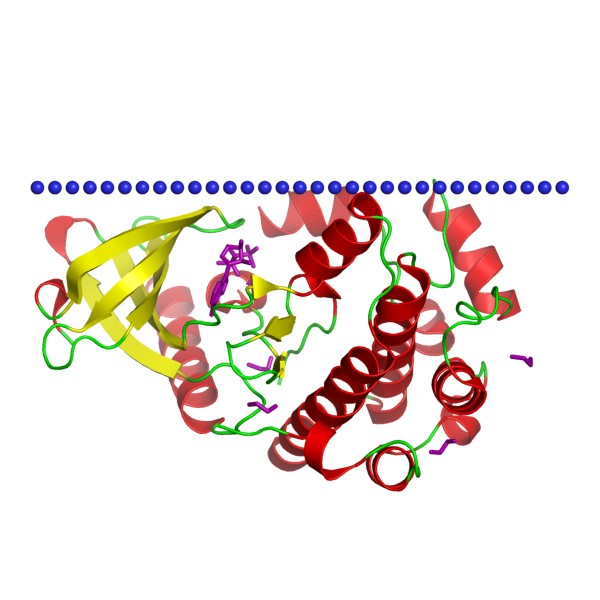Mempro™ Cell-Based Protein Kinase Superfamily Production
Creative Biostructure provides customers advanced Mempro™ Cell-Based protein kinase superfamily production service for both academic and industry applications.
Protein kinases catalyze the reversible phosphorylation of a various kind of proteins. They modify these proteins and act as important regulators of nearly all of cell functions and processes. Protein kinases regulate the activity of enzymes, the location and overall function of various proteins by adding the phosphate group reversibly to the substrate proteins. The protein kinase superfamily is one of the largest homologous protein superfamilies, 478 of all the more than 500 protein kinases belong to this single superfamily as their catalytic domain are related in sequence.
 Figure 1. The schematic structure of Serine/threonine-protein kinase Nek2. (OPM Database)
Figure 1. The schematic structure of Serine/threonine-protein kinase Nek2. (OPM Database)
With years of experience in membrane protein production, Creative Biostructure can provide high quality Mempro™ custom cell-based protein kinases superfamily production services. With Creative Biostructure's Mempro™ membrane protein production service, your protein kinase production services will be easier and your cost will become lower. All kinds of expression systems are available in Creative Biostructure to meet different experimental requirements of customers, including:
Mempro™ Protein Production in Bacterial Cells System;
Mempro™ Protein Production in Yeast Cells System;
Mempro™ Protein Production in Incest Cells System;
Mempro™ Protein Production in Mammalian Cells System.
Cell-based systems are the most widely applied methods for recombinant soluble/membrane protein production. Based on the characteristics of target protein kinase and your special requirements, our science team will establish optimal strategy in each individual case. We choose the bacteria system as our common first choice as it is simple, fast, relatively cheap and high yield. Multiple bacteria expression vectors and host cells are available. But in some cases the target protein is difficult to express or fold correctly. What's more, the bacteria system can't achieve post-transcriptional modifications. Yeast systems combine the advantages of both prokaryotic and eukaryotic systems such as relative economic costs, single cells, and high cell densities, faster grow rates, etc. Insect cell systems are developed from transfected cells of insects and combined with vectors derived from the baculovirus species AcMNPV. The most powerful expression systems are the mammalian cell systems, as they provide nearly-native intracellular environments for the expression of target protein kinase. Cell lines derived from various mammalian cells such as HEK293, CHO, BHK-21, COS, HeLa and GH3 are widely applied for integral membrane protein production. But insect cell and mammalian cell systems are relatively expensive and complex.
Creative Biostructure also provides a wide range of other custom membrane protein production services with multiple advanced technologies. Welcome to contact us for more details.
References:
Hanks S K, Hunter T. Protein kinases 6. The eukaryotic protein kinase superfamily: kinase (catalytic) domain structure and classification[J]. The FASEB journal, 1995, 9(8): 576-596.
C. Trometer, and P. Falson (2010). Mammalian membrane protein expression in baculovirus-infected insect cells. Methods Mol. Biol., 601: 105-117.
S. Schlegel, et al. (2013). Bacterial-based membrane protein production. Biochim. Biophys. Acta., 1843(8): 1739-1749.